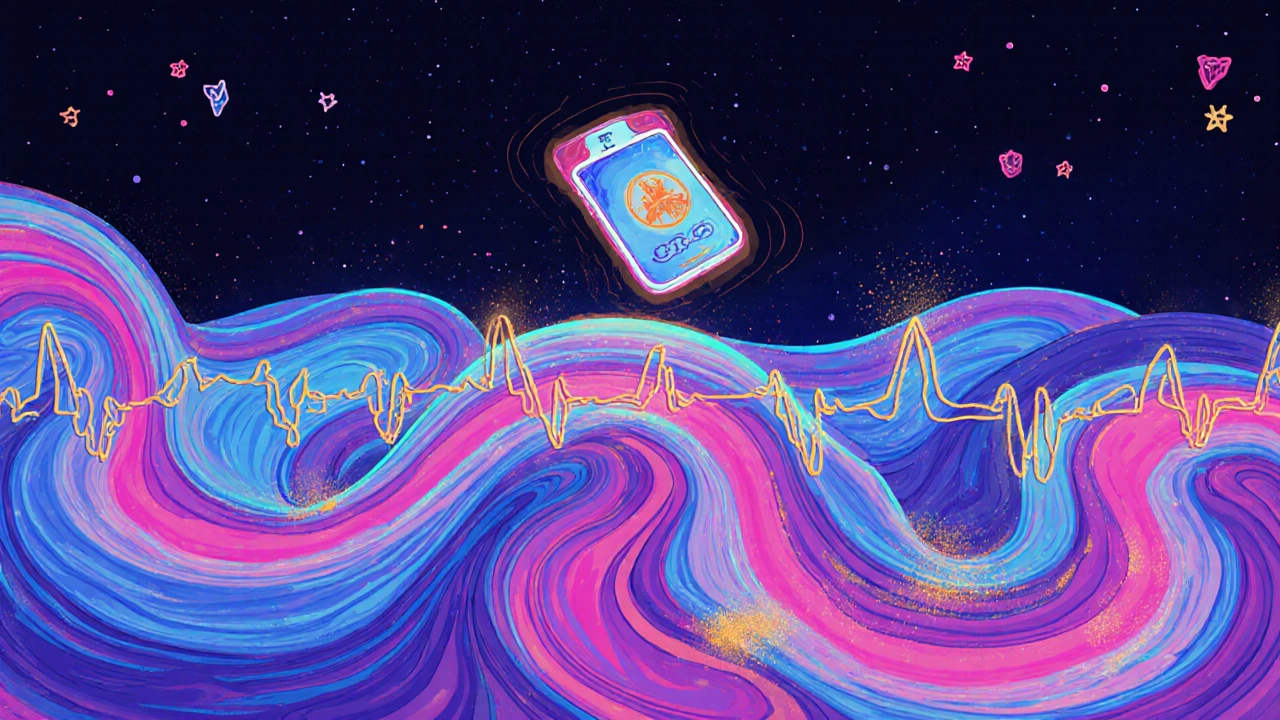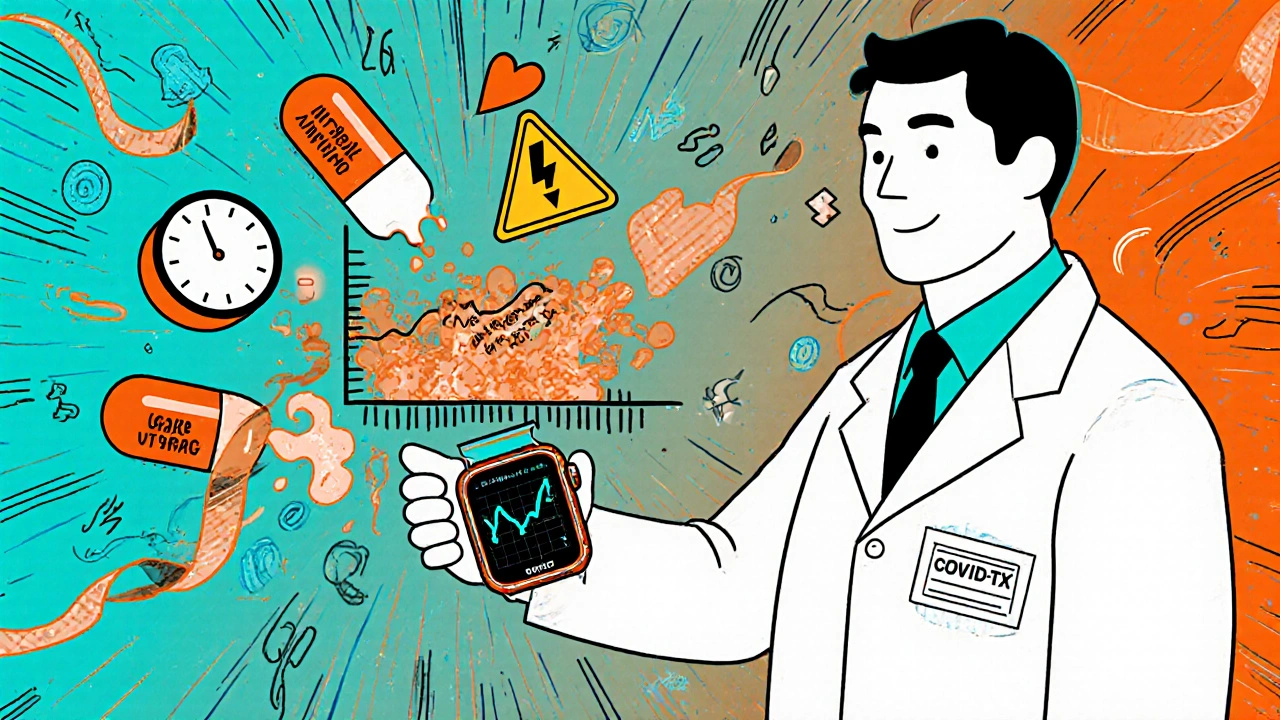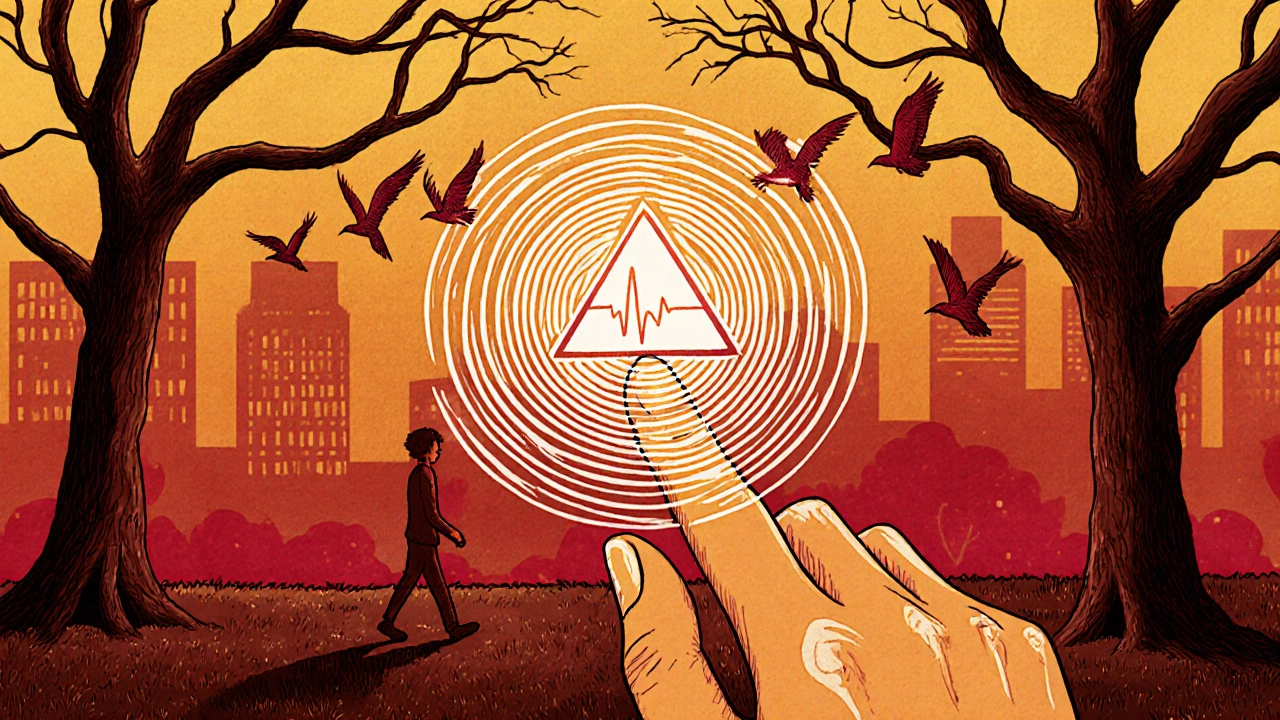Wearable ECGs for QT Safety: Real-Time Risk Detection

QT Interval Calculator
Calculate your corrected QT interval (QTc) using Bazett's formula. Enter your QT interval (ms) and heart rate (bpm) from wearable ECG readings to assess cardiac risk.
Results
Why QT Interval Monitoring Matters More Than Ever
Every heartbeat has a hidden electrical rhythm. The QT interval is one of the most important parts of that rhythm - it’s the time between the start of the Q wave and the end of the T wave on an ECG. If this interval gets too long, it can trigger a dangerous heart rhythm called torsades de pointes, which can lead to sudden cardiac arrest. This isn’t rare. Over 100 medications - including common antibiotics, antipsychotics, and even some COVID-19 treatments - are known to prolong the QT interval. For patients on these drugs, missing a dangerous spike in QT length can be deadly.
Traditionally, doctors relied on clinic-based 12-lead ECGs to check this. But those are snapshots. They don’t catch changes that happen hours after a dose, or during sleep, or while walking. That’s where wearable ECGs come in. They don’t just record heartbeats - they monitor the QT interval in real time, day and night. This isn’t science fiction. It’s happening now, in homes, in clinical trials, and in emergency rooms.
How Wearable ECGs Measure QT Intervals
Not all wearables are the same. The Apple Watch Series 4 and later models have an FDA-cleared ECG app that records a single-lead ECG when you touch the digital crown. It’s simple: place your finger on the crown for 30 seconds, and it captures your heart’s electrical activity. But it only gives you one view - like looking at a building through a single window.
Then there’s the KardiaMobile 6L. This small device, about the size of a credit card, has electrodes on both top and bottom. You place your thumbs on the top, and your left foot on the bottom. It creates a six-lead ECG - almost as complete as a hospital machine. Studies show its QT measurements match standard 12-lead ECGs within 20 milliseconds. That’s clinically acceptable. For patients on high-risk drugs, this means real-time alerts if their QT interval starts creeping up.
Accuracy isn’t perfect. A 2021 study in Scientific Reports found the Apple Watch correlated strongly with standard ECGs - Spearman’s correlation above 0.88 for key leads. But it struggled with detecting abnormal Q waves, with sensitivity as low as 20.6%. That’s why these devices aren’t meant to replace doctors. They’re meant to give doctors better data.
The Pandemic That Changed Cardiac Monitoring
In early 2020, hospitals were overwhelmed. Patients with COVID-19 were being treated with hydroxychloroquine and azithromycin - both known to prolong QT. But doctors couldn’t see every patient every day. That’s when the FDA stepped in. In April 2020, it issued emergency guidance allowing the use of KardiaMobile 6L and similar devices to monitor QT intervals remotely. It was the first time the agency formally recognized consumer-grade wearables as valid tools for cardiac safety.
Dr. Jason Chinitz published a landmark case report in 2020 showing how an Apple Watch caught dangerous QT prolongation in a COVID-19 patient on these drugs. Without the wearable, the spike might have gone unnoticed until it was too late. That case became a turning point. Suddenly, wearable ECGs weren’t just for fitness. They were lifesaving tools.
Since then, 16 studies have validated the KardiaMobile 6L for QT measurement. The Cleveland Clinic’s 2024 review concluded that the device’s readings are noninferior to standard ECGs. For patients on long-term QT-prolonging drugs - like those with psychiatric conditions or inherited arrhythmias - this means fewer hospital visits and earlier warnings.

Where Wearables Fall Short
Don’t mistake convenience for completeness. These devices can’t detect every problem. They’re great at spotting QT prolongation - but they’re not designed to diagnose heart attacks, atrial flutter, or complex arrhythmias. A 2024 review in the Cleveland Clinic Journal of Medicine noted that consumer wearables still lack algorithms to interpret complex waveforms. The Apple Watch, for example, doesn’t automatically calculate QTc. It shows the ECG trace - and leaves interpretation to the clinician.
Signal quality matters too. Sweat, poor skin contact, or movement can distort readings. The FDA’s 2020 guidance warned about high skin-to-electrode impedance, especially in older adults or those with dry skin. That’s why training is critical. Patients need to know how to position the device correctly. With the KardiaMobile 6L, placing your foot on the bottom electrodes isn’t optional - it’s part of the circuit. Skip it, and you get garbage data.
And while the Apple Watch can record a single-lead ECG in seconds, it doesn’t continuously monitor. You have to start it manually. That’s a gap. For patients at highest risk, continuous monitoring - like a Holter monitor - is still the gold standard. But wearables are the next best thing.
AI Is Making Real-Time QT Detection Possible
The biggest leap forward isn’t in hardware - it’s in software. In 2024, researchers at Stanford published a study in PLOS Digital Health that used a deep learning model to predict QT prolongation from just two beats of a single-lead ECG. The model, built on a Residual Neural Network, analyzed data from 686 patients, half with long QT syndrome. It identified QTc > 500ms - the threshold for high risk - with over 90% accuracy.
This is huge. Right now, every ECG from a wearable device needs a cardiologist to review it. That’s slow. That’s expensive. That’s a bottleneck. AI changes that. Imagine a smartwatch that doesn’t just show a trace - it says, “Your QT interval is rising. Contact your doctor.” No waiting. No delay. This isn’t coming next year. It’s already being tested in clinical trials.
Pharmaceutical companies are already using these devices in Phase I-III trials to monitor cardiac safety in real time. Instead of sending patients to clinics every few days, they’re collecting continuous data from home. That speeds up trials, cuts costs, and improves safety. One company, VivaLink, reported that wearable ECGs are now standard in over 40% of cardiac safety trials - up from just 8% in 2020.

What This Means for Patients and Doctors
If you’re on a drug that affects your QT interval - whether it’s an antibiotic, antidepressant, or antifungal - talk to your doctor about wearable monitoring. You don’t need a prescription for the Apple Watch or KardiaMobile 6L. But you do need to understand how to use them. The device won’t save you if you don’t use it right.
For doctors, this is a game-changer. You get a continuous stream of data instead of one snapshot. You can see trends. You can spot a slow, dangerous rise in QT before it becomes an emergency. You can adjust doses earlier. You can avoid hospitalizations.
And for researchers, this opens the door to real-world evidence. We’re no longer limited to controlled lab settings. We can see how QT intervals behave in real life - during stress, sleep, exercise, or after meals. That’s the kind of data that leads to better guidelines, better drugs, and better outcomes.
The Future Is Continuous
Wearable ECGs for QT monitoring are still young. But they’re growing fast. By 2026, we’ll likely see smart rings and clothing with embedded sensors that monitor QT continuously - without you even having to press a button. The next generation of devices will combine AI, multi-lead sensing, and automatic alerts. The goal isn’t just to detect QT prolongation. It’s to prevent sudden cardiac death before it happens.
This isn’t about replacing hospitals. It’s about extending care beyond them. It’s about giving people with high-risk conditions the same protection as someone in an ICU - but in their own home, on their own schedule. The technology is here. The data is there. All that’s left is to use it right.
Alyssa Fisher
November 9, 2025 AT 06:28It’s wild how we’ve gone from needing a clinic visit every few weeks to having a device in our pocket that can catch a lethal arrhythmia before it happens. This isn’t just tech-it’s a paradigm shift in preventive care. The fact that we’re now using consumer hardware to monitor something as critical as QT interval means medicine is finally catching up to the reality of daily life. No more waiting for symptoms. No more guessing. Just data. Real, continuous, actionable data.
Jim Oliver
November 11, 2025 AT 04:42Wow. So we’re just gonna let people with zero medical training interpret ECGs now? Great. Next thing you know, someone’s gonna diagnose their own MI from an Apple Watch and sue the hospital because they didn’t ‘warn’ them.
Brierly Davis
November 11, 2025 AT 09:02Hey, don’t be like that Jim 😅 The point isn’t to replace doctors-it’s to give them better tools. I’ve got a cousin on antipsychotics, and her doc started using KardiaMobile after she had a near-miss. Now she gets alerts before her QT spikes. That’s not magic. That’s just smart medicine. And yeah, you still gotta see your cardiologist-but now you’re coming in with data, not just ‘I feel weird.’
Jay Wallace
November 12, 2025 AT 03:38So… we’re letting Silicon Valley medics replace actual cardiology? The Apple Watch doesn’t even know what a Q wave is. It’s a glorified pedometer with a heartbeat sensor. And now we’re trusting it with life-or-death decisions? Please. If you’re on QT-prolonging meds, you need a Holter, not a wristwatch. This is American tech arrogance wrapped in a ‘health hack’ bow.
Alyssa Salazar
November 13, 2025 AT 01:48Okay but let’s talk about the AI model from Stanford-ResNet trained on 686 patients, detecting QTc >500ms from TWO BEATS? That’s insane. We’re talking about a neural net that can predict torsades risk faster than a human can blink. And it’s not even in consumer apps yet. Imagine a future where your smart ring buzzes at 3 a.m. because your QTc just crossed 500ms-and your EHR auto-sends a flag to your prescriber. This isn’t sci-fi. It’s 2025. And we’re already halfway there.
Amber O'Sullivan
November 14, 2025 AT 19:42William Priest
November 15, 2025 AT 02:52Yeah right. ‘Real-time risk detection’ my ass. The FDA cleared these devices under emergency use during a pandemic when hospitals were collapsing. That’s not validation-it’s desperation. And now they’re being sold like fitness trackers. People think their watch is a cardiologist. It’s not. It’s a glorified pulse oximeter with a screen. And don’t even get me started on the signal noise from sweat or dry skin. You think your grandma’s gonna hold her foot on the electrode for 30 seconds? Ha. This whole thing’s a liability waiting to happen.
Beth Banham
November 15, 2025 AT 04:01I’ve been using the KardiaMobile for six months now. I have LQTS. I used to get panic attacks before every clinic visit. Now I just tap the device when I feel off. Most times it’s nothing. But twice, it caught a slow rise in QT before I even noticed symptoms. My doctor changed my dose based on the trend-not one snapshot. I’m alive because of this. Not because of some fancy AI. Because someone listened to the data. And I didn’t have to drive an hour every month to prove I wasn’t dying.
Ryan Masuga
November 15, 2025 AT 10:27Y’all are overthinking this. The tech isn’t perfect? Neither is your doctor. But now you’ve got something that gives you a fighting chance between visits. I’ve got my dad on amiodarone. He forgets to take his meds, forgets to go to appointments. But he remembers to check his watch. That’s progress. You don’t need a PhD to use it-you just need to care enough to try. And if it saves one life? Worth it. No fluff. Just do it.